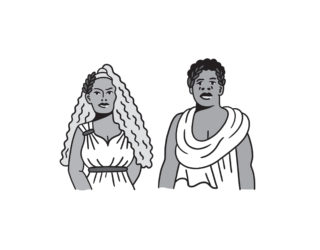It’s time to start interrogating the gendered dynamics at play in the musician’s vampiric relationship with his muse
An alternative is more than just out there – it’s here

An alternative is more than just out there – it’s here
Despite the vice-like grip that dead white men have on the cultural canon, Greek myth would have it that it’s women we have to thank for the joys of art, music, philosophy and pretty much every act of human creativity. Specifically, we should direct our gratitude towards the Muses: divine offspring of the Olympian Zeus and the celestial embodiments of everything that can be vaguely described as “arty”. Naturally, being goddesses, they’re in possession of cookie-cutter good looks – but that’s by far their least interesting quality.
With unparalleled talents in the arts, the muses were fabled for helping Grecians forget their troubles, and supposedly served as inspiration to the writers of ancient civilisation. Classical poets would begin their work with an ode to the muses, wishing that theses deities would grant a smidgen of their talent to the writerly endeavour at hand, and a twisted version of this tradition has lived on in contemporary culture. Specifically, the “muse” is alive and kicking – but it’s the songwriter, rather than the verse writer, that has her in his (and it’s almost always his) sights. The power dynamic, funnily enough, is also flipped. Rather than the poet’s words aggrandising the lofty muses, the songwriter’s lyrics break the muse apart, reducing her to a few catchy lines or a plaintive chorus.
Many women have populated the songs of rock music and whilst the women behind these songs never graced the limelight themselves – though there are always exceptions to this rule – they’ve made a profound impact on musical culture. Visualising and documenting this impact was no doubt some of the rationale behind the recently released documentary Marianne & Leonard: Words of Love, which focuses on Leonard Cohen’s relationship with Marianne Ihlen, who inspired the song ‘So Long, Marianne’ and several songs on Cohen’s first album. Besides its nauseating title, there’s a lot that’s wrong with this Nick Broomfield-directed feature. Feeding into the narrative of the “genius” musician, Cohen is genuinely described as someone who “couldn’t give himself to them [the many women who fancied him], because he couldn’t give himself away.” Hmmm. Interesting. Whilst Cohen can’t “give himself away” it seems like this is his muse’s defining quality. As the film shows, Ihlen was there to be picked up, dropped, and then picked up again at the musician’s will, for she gave herself wholeheartedly – her image, her love, her sexuality – to him and, by extension, his art. She is something to be used up by his all-consuming talent and never an individual with her own right to create or contribute.
There’s no denying that love and sex can be powerful creative stimulants, and I’m certainly not saying we should give up on this tradition (what would the world be without love songs?!). It’s more like we should start interrogating the gendered dynamics at play in the musician’s vampiric relationship with his muse. An alternative is more than just out there – it’s here, and it comes in the shape of mutually beneficial collaboration between couples where partners serve as both muse to one another and creator of their shared project. Concretely, recent years have seen the release of outstanding collaborative records such as the Carters’ Everything is Love from 2018, Eris Drew and Octo Octa’s Devotion EP from the same year or Conor Oberst’s and Phoebe Bridgers’s Better Oblivion Community Center (inspired by the joys of their close friendship, not love) in 2019. This kind of relationship isn’t just necessarily the product of our “enlightened” present, with the examples of fruitful creative projects from couples Tom Waits and Kathleen Brennan, and Laurie Anderson and Lou Reed, stretching considerably further back. However, the re-evaluation of the muse concept in recent years, in addition to the heightened possibilities of couple-duos in music, has undoubtedly been facilitated by a shift in gendered power dynamics at a personal level and the increased visibility of women in wider society as well as specifically within the music industry.
Yet could there be another reason for this sudden reclaiming of the muse, and its repurposing to more egalitarian ends? Perhaps in the times of economic, political and financial uncertainty that we live in, we want to put our faith in the people around us, to anchor our confidence in our lovers and friends while the world goes up in flames around us. In an era of hostility where bodies – particularly marginalised bodies – are coming under attack from misogyny, white supremacy and an increasingly inhospitable environment, mutual care and trust becomes paramount. There is only so much “self care” we can do, particularly as even this means of resistance becomes co-opted by corporations keen to seduce customers into spending their money but give little in return.
Genuine care for others is a restorative force, something that fortifies both us and our partners, family or friends – and is thus one of the last resolves we have against the surreal times we live in. Love, then, becomes a radical instrument in its own right, and integrating it into the mix – as Octo Octa, Eris Drew, and the Carters have done – might just bring music to giddy new heights.